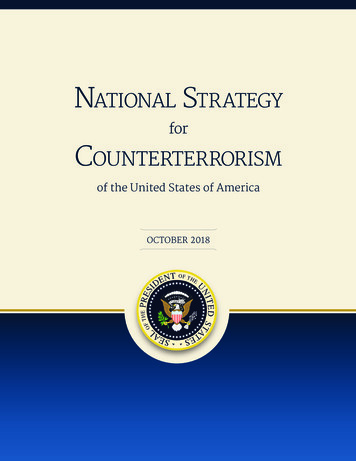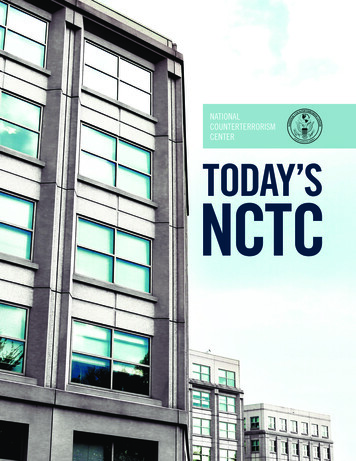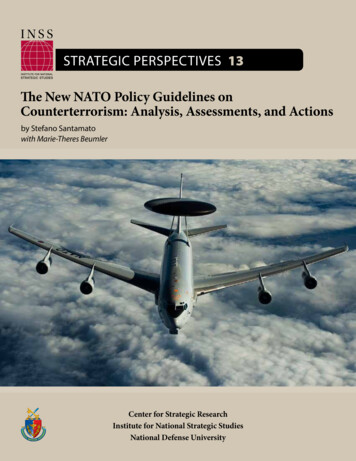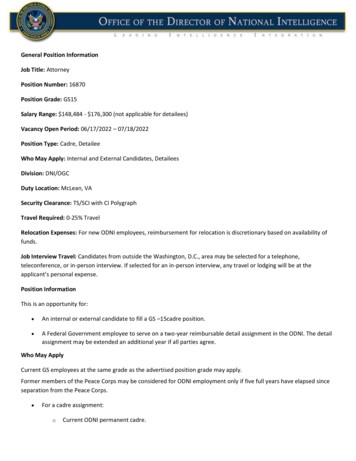
Transcription
National StrategyforCounterterrorismof the United States of AmericaOCTOBER2018
THE WHITE HOUSEWASHINGTON, DCMy fellow Americans:I made a solemn promise to the American people to spare no effort to preserve thesafe ty and se curity of the Unite d State s. This National Strate gy for Counte rte rrorismhelps keep that promise. We must defeat the terrorists who threaten America’s safety,prevent future attacks, and protect our national interests. This requires a new approachto combatting and preventing terrorism.In fulfilling my promise to renew America’s strength and security, I have revitalized ourmilitary, and we are now, through action and leadership, prevailing against the terroristsaiming to harm us and our interests. We are using all available tools at our disposal tocombat terrorist groups, starve them of support, and prevent them from recruiting ne wfollowe rs. We are also disrupting te rrorist thre ats within our own borde rs, fromindividuals mobilized to violence by a range of domestic and foreign terrorist ideologiesand who threaten our safety.This has not be e n e asy. My Administration inhe rite d a world in which the te rroristthreat had become more complex and widespread than ever before. We, the people ofthe United States, face global terrorist networks and their affiliates. We face terroristorganizations backed by state sponsors. And we face homegrown threats inspired byterrorist propaganda.The National Strategy for Counterterrorism recognizes the full range of terrorist threatsthat the United States confronts within and beyond our borders, and emphasizes theuse of all elements of national power to combat terrorism and terrorist ideologies. Itenhances our emphasis on targeting terrorist networks that threaten the United Statesand our allies and on disrupting and denying their ability to mobilize, finance, travel,communicate, and inspire new followers. We will deny terrorists the freedom to traveland communicate across inte rnational borde rs, and we will take action to limit the irability to recruit and radicalize online. We will combat the violent, extreme, and twistedideologies that purport to justify the murder of innocent victims. We will also ensurethat America’s critical infrastructure is protected, in order to deter and prevent attacks,and is resilient so that we can quickly recover should it come under attack.
This National Strategy for Counterterrorism sets forth a new approach. We will protect ourhomeland, our interests overseas, and our allies and partners. We will defeat radical Islamist terrorists such as ISIS and al-Qa'ida, expand our agile counterterrorism toolkit to preventfuture terrorist threats, deter emerging threats, roll back Iran's global terrorist network, andensure our country's continued safety. Now, and in the future, we will secure our Nation andprevail against terrorism.Sincerely,President Donald J. TrumpThe White HouseOctober 2018
e xeCutive SummaryWe Remain a Nation at WarToday's terrorist landscape is more fluid and complex than ever. For this reason,counterterrorism remains a top priority for this Administration. Our principal terroristenemies are radical Islamist terrorist groups that seek to conduct attacks globally,violate our borders, and radicalize and recruit potential extremists within the UnitedStates and abroad. We continue to face threats from Iran, the most prominentstate sponsor of terrorism, through its global network of operatives and its ongoingsupport to an array of terrorist groups. Terrorists motivated by other forms ofextremism also use violence to threaten the homeland and challenge UnitedStates interests. These terrorist threats are different in many ways, but they all seekto use violence to undermine the United States and disrupt the American way oflife.pressure on terrorist organizations to prevent themfrom reemerging.Since September 11, 2001, we have learned thatwinning the war on terrorism requires our countryto aggressively pursue terrorists. We have alsolearned, however, that we must do more thanmerely kill or capture terrorists. We must dismantleterrorists' networks and sever the sources of strengthand support that sustain them, that allow them toregenerate, and that permit them to adapt. To securea lasting victory, we must also maintain sufficientThis Administration has already taken significantsteps to address the terrorist threat. Under theleadership of President Donald J. Trump, the UnitedStates has accelerated efforts to defeat thoseterrorists who pose a threat to the United States. Forinstance, working with coalition partners, we have This strategy uses all available instruments of United States power to counter terrorism. We willdefeat our enemies with the full force of America’s strengths. This strategy will protect the United States against all terrorists that threaten our country. We willnot focus on a single organization but will counter all terrorists with the ability and the intent toharm the United States, our citizens, and our interests abroad. This strategy places America First and emphasizes protection of the homeland—building strongborders, strengthening security at all ports of entry into the United States, protecting its criticalinfrastructure, and facilitating preparedness. This strategy recognizes, however, that America First does not mean America alone. We willbroaden our range of partners to combat radical Islamist terrorism, Iran-sponsored terrorism,and other forms of violent extremism; encourage capable partners to play a larger role incounterterrorism efforts; and assist other partners so that they can eventually address terroristthreats independently.i
NATIONAL STRATEGY FOR COUNTERTERRORISMliberated nearly all of the territory once controlled bythe self-declared Islamic State of Iraq and al-Sham(ISIS) in Iraq and Syria. While we have made muchprogress, additional challenges remain. We mustcontinually work to stay ahead of an adaptive enemy.This means that we must undertake additional effortsto prevent terrorists from acquiring or using weaponsof mass destruction (WMD) and other advancedattack capabilities. We must prevent terrorists fromexploiting new technologies in today’s dynamicinformation environment, and we must counterterrorists’ ability to recruit and radicalize online andthrough other means.This means collaborating so that foreign governmentstake the lead wherever possible, and working withothers so that they can assume responsibility inthe fight against terrorists. Domestically, we mustempower our frontline defenders—our state andlocal law enforcement professionals—as well as manyother government, civil society, and private sectorpartners to prevent and counter terrorism in theUnited States.Building on the National Security Strategy and theAdministration's progress to date, the NationalStrategy for Counterterrorism outlines how the UnitedStates will combat terrorism at home and abroadand keep America safe. Acting in accordance withthis strategy, we will defeat our enemies, just as wehave defeated the purveyors of oppression, fascism,and totalitarianism in previous wars. We will alwaysremember September 11, 2001, and the sacrificesmade by so many brave patriots in defense of ourcountry against the evil scourge of terrorism. Withthat same spirit of service and self-sacrifice, we willsafeguard the homeland, protect our way of life, andeliminate our enemy’s ability to threaten our country.We are a nation at war—and it is a war that the UnitedStates will win.Likewise, experience has taught us that preparednessand prevention must be integral parts of our counterterrorism strategy. We must protect the homelandagainst the terrorist threat by building strong borders,securing United States infrastructure, and enhancingthe preparedness of the American people.Experience has also highlighted the importance ofstrong partnerships in sustaining our counterterrorismefforts. Whenever possible, the United States mustdevelop more efficient approaches to achieve oursecurity objectives, relying on our allies to degradeand maintain persistent pressure against terrorists.ii
TableofContentsIntroduction.1National StrategyforCounterterrorismat aGlance. 5The Terrorist Adversary. 7PrioritizationandResourcing. 11Pursue Terrorist ThreatstoTheir Source. 13Isolate Terrorists from Financial, Material, and LogisticalSources of Support. 15Modernize and Integrate a Broader Set of United States Tools andAuthorities to Counter Terrorism and Protect the Homeland. 17Protect United States InfrastructureandCounter Terrorist RadicalizationRecruitment. 21andEnhance Preparedness. 19Strengthen the Counterterrorism Abilities of International Partners. 23Conclusion.25iii
IntroductionThe Path to VictoryThe United States occupies a special role among nations as a vanguard of freedom,democracy, and constitutional governance. These luminous ideals must beassiduously defended in a world of increasing challenges and dangers from the forcesthat threaten America’s people, our vital interests, and the security and prosperity ofour allies and partners.Terrorists seek to undermine American ideals andthe United States Government by using violence andpropaganda to advance their depraved goals. Afterseventeen years of armed conflict and significantcosts in American blood and treasure, our efforts toprevent and counter terrorism have met with mixedsuccess. While we have succeeded in disruptinglarge-scale attacks in the homeland since 2001, wehave not sufficiently mitigated the overall threat thatterrorists pose.stated, “America is committed to adjusting ourstrategies to meet evolving threats and new facts.We will discard those strategies that have notworked—and will apply new approaches informed byexperience and judgment.”We must confront terrorists with the combinedpower of America’s strengths—our strong military,our law enforcement and intelligence communities,our civilian government institutions, our vibrant private sector, our civil society, our international partnerships, and the firm resolve of the American people.Harnessing our full potential, the spirit of innovationthat has been key to our national greatness, and ourtradition of working together toward our commongoals, we will prevail and prevent terrorism from disrupting the American way of life.Today’s terrorist threats have changed, and terroristgroups are now more geographically dispersedand their tactics more diversified. To address thisevolving terrorist threat across the globe and withinthe homeland, our approach to counterterrorismmust evolve. As President Donald J. Trump hasThrough the National Strategy for Counterterrorism, we will achieve the following end states tosafeguard our homeland, way of life, and shared interests: The terrorist threat to the United States is eliminated; Our borders and all ports of entry into the United States are secure against terrorist threats; Terrorism, radical Islamist ideologies, and other violent extremist ideologies do notundermine the American way of life; and Foreign partners address terrorist threats so that these threats do not jeopardize thecollective interests of the United States and our partners.1
NATIONAL STRATEGY FOR COUNTERTERRORISMTo achieve these aims, this strategy adopts anAmerica First approach to counterterrorism—onethat is guided by United States interests; shaped byrealistic assessments of both our challenges and ourcapabilities; and attuned to the important roles of ourallies and partners, both foreign and domestic, in ourshared counterterrorism efforts.strategic communications. These tools are an integralpart of our counterterrorism activities, and we willcontinue to incorporate them when appropriate tomaximize their effects.In addition, this strategy prioritizes a broader range ofnon-military capabilities, such as our ability to preventand intervene in terrorist recruitment, minimize theappeal of terrorist propaganda online, and build societal resilience to terrorism. This includes leveragingthe skills and resources of civil society and non-traditional partners to diminish terrorists’ efforts to radicalize and recruit people in the United States.This strategy differs from previous strategies in thatit adopts a more agile and expansive approach thataddresses the full spectrum of terrorist threats to theUnited States, including our enemies overseas and thepeople they seek to influence and mobilize to violencein the United States. We will also confront the threat ofterrorists in the United States who seek to further theirTo defeat radical Islamist terrorism, we must alsopolitical or social aims throughspeak out forcefully against aunlawful acts of violence withouthateful ideology that providesforeign direction or inspiration. In thisthe breeding ground for violence“But above all, we mustpursuit, we will continue to protectand terrorism. We will expose thebe united in pursuingAmerican freedoms, and we will bedestructive, totalitarian naturetheonegoalthatunwavering in our commitment toof the ideology that fuels violentdefeat all those who turn to violenceradical Islamist movements, suchtranscends every otherin an attempt to destroy, disrupt, oras ISIS and al-Qa'ida. We will revealconsideration. Thatimpair our society.the way violent radical Islamistgoal is to meet history’sterrorists have killed, exploited,Importantly, this America Firstand betrayed Muslim communities,great test—to conquerapproach will harness the full spanincluding women and children.extremism and vanquishof United States power and useThrough our efforts, we will thwarttheforcesofterrorism.”every available tool to combatterrorists' ability to exploit theterrorism at home, abroad, and inInternet for directing, enabling, orPRESIDENTDONALD J. TRUMPcyberspace. This includes militaryinspiring attacks.and intelligence op er at ionsoverseas, law enforcement actionsWe will not do this alone. Thisat home and abroad, diplomatic engagement, andstrategy recognizes that effective counterterrorismthe use of financial tools. We will modernize andrequires a wide range of public and private sectorintegrate existing counterterrorism tools so we canpar tners as well as foreign par tnerships. A ssecure our borders through, among other things,President Trump stated, “We must seek partners,more rigorous scrutiny of entry applications. Wenot perfection—and to make allies of all who sharewill also deploy new technologies precisely whereour goals.” Accordingly, from civil society and state,they are needed and protect critical infrastructurelocal, tribal, and territorial governments to privatein the United States from terrorist attacks. Finally,sector partners and foreign allies, the full range of ourwe will incorporate two of the most potent tools inpartnerships must be enhanced to effectively preventthe information environment: cyber operations andand counter terrorist activity, particularly as tactics2
INTRODUCTIONThrough this new approach, the United States will integrate our instruments of national powerto achieve our end states through the following strategic objectives:The capacity of terrorists to conduct attacks in the homeland and against vital UnitedStates interests overseas is sharply diminished;The sources of strength and support upon which terrorists rely are severed;Terrorists’ ability to radicalize, recruit, and mobilize to violence in the homeland isdiminished;Americans are prepared and protected from terrorist attacks in the homeland,including through more exacting border security and law enforcement actions;Terrorists are unable to acquire or use WMDs, including chemical, biological,radiological, and nuclear weapons, and other advanced weaponry; andPublic sector partners, private sector partners, and foreign partners take a greaterrole in preventing and countering terrorism.and actors can change quickly. We will expect moreof our partners in this fight, but they will never doubtour resolute commitment to defending our sharedinterests.(informed by research, intelligence, and analysis)to ensure that we are making measurable progresstoward our strategic objectives. By rigorously monitoring our progress and measuring the impact ofour activities, we can make informed adjustmentswhen needed to advance our counterterrorismefforts.All the while, we will be pragmatic in our approachand mindful of the need to use our resources carefully. This strategy, therefore, prioritizes United Statescounterterrorism efforts against those terrorists withthe ability and intent to harm the United States andour vital national interests and limits United Statesefforts overseas to those that directly bolster ournational security. Likewise, to maximize the effectiveness of our actions, we will continue to integrate United States Government counterterrorismefforts. Finally, we will continually review the efficacyof our approach through independent assessmentsGuided by this strategy, rooted in American principles,and harnessing our inherent strengths as a nation, wewill eliminate terrorists’ ability to threaten America,our interests, and our engagement in the world. TheUnited States—forever the sentinel of democracy andfreedom—will prevail over terrorism and preservethe American way of life. Through our triumph, wewill demonstrate that American strength remains alasting force for good in the world.3
NATIONAL STRATEGY FOR COUNTERTERRORISMNational StrategyforCounterterrorismat aGlanceThe strategic objectives are critical to reaching the desired end states, and the lines of effort are the meansfor achieving them.STRATEGIC OBJECTIVESThe capacity of terrorists to conductattacks in the homeland andagainst vital United States interestsoverseas is sharply diminishedAmericans are prepared and protected fromterrorist attacks in the homeland, includingthrough more exacting border security and lawenforcement actionsThe sources of strength and supportupon which terrorists rely areseveredTerrorists are unable to acquire or use Weaponsof Mass Destruction (WMD), including chemical,biological, radiological, and nuclear weapons,and other advanced weaponryTerrorists’ ability to radicalize,recruit, and mobilize to violence inthe homeland is diminishedPublic sector partners, private sector partners,and foreign partners take a greater role inpreventing and countering terrorismEND STATESThe terrorist threat to the United States iseliminatedOur borders and all ports of entry into the UnitedStates are secure against terrorist threatsTerrorism, radical Islamist ideologies, and otherviolent extremist ideologies do not underminethe American way of lifeForeign partners address terrorist threats so thatthese threats do not jeopardize the collectiveinterests of the United States and our partners.LINES OF EFFORTPursue terrorist threats to their sourceIsolate terrorists from financial, material, andlogistical sources of supportModernize and integrate a broader set of UnitedStates tools and authorities to counter terrorismand protect the homelandProtect United States infrastructure and enhancepreparednessCounter terrorist radicalization and recruitmentStrengthen the counterterrorism abilities ofinternational partners5
The Terrorist A dversaryThe United States and our allies face an increasingly complex terrorist landscape,populated by a diverse array of actors employing new technologies and tacticsto advance their agendas. The terrorist threat to the United States is growingmore dynamic and diffuse as an increasing number of groups, networks, andindividuals exploit global trends, including the emergence of more secure modes ofcommunications, the expansion of social and mass media, and persistent instabilityacross several regions.Radical Islamist terrorists remain the primary transdevices to defeat aviation security measures, andnational terrorist threat to the United States andusing high-quality media products to recruit extremit s vital national interest s.ists in the West. Future radicalProminent terrorist organiIslamist terrorists and other terzations, particularly ISIS androrists will continually adapt“ISIS is on a campaignal- Qa'ida, have repeate dlythese and other tactics to theirof genocide, committingdemonstrated the intent andcircumstances and the technocapability to attack the homelogical advances of the age. It is,atrocities across the world.land and United States intertherefore, critical that the UnitedRadical Islamic terroristsests and continue to plot newStates counterterrorism posare determined to strike ourattacks and inspire susceptibleture be agile enough to adapt aspeople to commit acts of viowell.homeland, as they did onlence inside the United States.19/11, as they did from BostonThese groups stoke and exploitRadical Islamist terrorists haveto Orlando to San Bernardinoweak governance, conflict, instaa violent extremist ideolog ybility, and longstanding politithat ser ves to create a comand all across Europe.”cal and religious grievances tomon identity and sense of purPRESIDENTpursue their goal of eliminatingpose for those susceptible to itsDONALD J. TRUMPWestern influence in majoritycore message. This vile ideolMuslim countries and remakingogy is used to indoctrinate newIslamic society.recruits to accept terrorist groups' goals and directives without question, and also allows these groupsRadical Islamist terrorist groups have developedto maintain cohesion, ensure conformity, and jusand used methods that have challenged Unitedtify the use of violence to meet the ideology's goals.States counterterrorism efforts, including estabIt avails terrorists of a worldview that helps unifylishing state-like governing institutions within theirtheir efforts by fomenting conflict and attempts tosafe havens, deploying sophisticated explosivelegitimize terrorism by elevating the social status ofThe intelligence and law enforcement communities refer to an individual in the United States radicalized and mobilized to violence by radical Islamistterrorist ideologies as a homegrown violent extremist (HVE).17
NATIONAL STRATEGY FOR COUNTERTERRORISMgroup members and absolving individuals from culpability for their participation in violence. Becauseof this, we must ensure that our efforts will undermine the appeal of this ideology of hate. Its resilience, power, and appeal make it a grave dangerto not just our own nation’s security but also thatof our allies across the globe. Without the appealof this ideology, radical Islamist terrorism has nofoundation.new routes. Europe's struggle to screen the peoplecrossing its borders highlights the importanceof ensuring strong United States borders so thatterrorists cannot enter the United States.In addition, the savagery of ISIS has caused a massive movement of millions of innocent refugees.Our battlefield successes, meanwhile, have givenway to the flight of thousands of terrorists seeking to evade justice. As defeated fighters and theirfamilies disperse, the United States and our partners must remain vigilant to ensure that terrorists cannot evade our security measures tothreaten our people and way of life.ISIS remains the foremost radical Islamist terroristgroup and the primar y transnational terroristthreat to the United States, despite ongoing UnitedStates and coalition civilian and military effortsthat have diminished the group's footprint in Iraqand Syria, killed thousands of its members, andcurtailed its global expansion. ISIS retains thefinancial and material resources and expertise tolaunch external attacks—including against UnitedStates interests—and its senior leaders continueto call for attacks against the United States. Thegroup's global reach remains robust, with eightofficial branches and more than two dozen networksregularly conducting terrorist and insurgentoperations across Africa, Asia, Europe, and theMiddle East. Despite many setbacks, ISIS maintainsa sophisticated and durable media and onlinepresence that allows it to encourage and enablesympathizers worldwide to conduct dozens ofattacks within target countries, including the UnitedStates. The increase in attacks by persons mobilizedto violence in the United States underscores theability of ISIS to inspire terrorist attacks.Meanwhile, al-Qa'ida's global network remainsresilient and poses an enduring threat to thehomeland and United States interests around theworld. Consistent United States-led counterterrorismpressure has removed many of its senior leadersand reduced the group’s ability to operate in SouthAsia, but its affiliates continue to plan and carryout terrorist attacks against the United States andour allies, as well as raise funds from individualsupporters through the international financialsystem. Affiliate resources are primarily focused onlocal and regional conflicts, but key operatives andelements within the network continue to seek outnew opportunities to strike the homeland and UnitedStates interests and to inspire attacks inside theUnited States. Veteran al-Qa‘ida leaders are workingto consolidate and expand the group’s presencein several regions, including in Syria, from which itaspires to launch new attacks against the UnitedStates and our allies.ISIS has been innovative and determined inits pursuit of attacks in the West. The grouphas exploited weaknesses in European bordersecurity to great effect by capitalizing on themigrant crisis to seed attack operatives into theregion. For instance, two of the perpetrators ofthe 2015 ISIS attacks in Paris, France, infiltratedthe country by posing as migrants. Further, ISISis continuing its efforts to circumvent Europeanefforts to shore up border security by identifyingBoth ISIS and al-Qa'ida have inspired peoplesusceptible to their malign influence to conductterrorist attacks inside the United States. Thiswill probably remain the most frequent form ofradical Islamist terrorism in the United States forthe next several years. Such attacks, motivatedby a wide range of factors, will continue to beconducted primarily through the use of simple8
THE TERRORIST ADVERSARYtactics against predominantly soft targets. ISISis likely to remain the main inspiration for suchattacks, particularly if the group can retain itsprominence and use social and mainstream mediacoverage to promote its violent message.Through the Islamic Revolutionary Guard CorpsQods Force (IRGC-QF), Iran's primary terrorist support arm, the Government of Iran provides financial and material support, training, and guidanceto Hizballah and other Shia militant groups operating in Bahrain, Iraq, Syria, and Yemen. It also supports HAMAS and other Palestinian terrorist groups.With operatives deployed around the world, theIRGC-QF has the capability to target United Statesinterests and possibly the homeland.In addition to ISIS and al-Qa'ida, dozens of other radical Islamist terrorist groups are working to advancemore locally focused insurgent or terrorist campaigns, while still posing a threat to United States persons and interests overseas. These groups, includingBoko Haram, Tehrik-e Taliban Pakistan, and Lashkar-eThere is also a broad range of revolutionary, nationTayyiba, employ a range of political and terrorist tacalist, and separatist movements overseas whose usetics to undermine local governments and conductof violence and intent to destabilize societies oftenattacks. These organizationsputs American lives at risk. Forwill probably prioritize regionalexample, the Nordic ResistanceMovement is a prominent transgoals over attacks against the“Iran and its proxiesnational, self-described nationhomeland or United Stateshave bombed Americanalist-socialist organization withinterests because of resourceembassies and militaryanti-Western views that has conconstraints or political conducted violent attacks againstsiderations. However, many ofinstallations, murderedMuslims, left-wing groups, andthese groups are hostile to thehundreds of Americanothers. The group has demonUnited States, maintain netservice members, andstrated against United Statesworks of sympathizers aroundthe world, and retain ties to ISISGovernment actions it perceiveskidnapped, imprisoned,or al-Qa'ida, underscoring theirare supportive of Israel and hasand tortured Americanthe potential to extend its tarpotential threat to United Statescitizens.”geting to United States interinterests.ests. Similarly, the neo-NaziPRESIDENTNational Action Group, a terrorIran remains the most promDONALD J. TRUMPist organization that was bannedinent state sponsor of terrorby the United Kingdom in 2016ism, supporting militant andterrorist groups across the Middle East and cultifor its promotion of violence against politicians andvating a network of operatives that pose a threat inminorities, operates mainly in the United Kingdomthe United States and globally. These groups, mostbut has engaged with like-minded groups in thenotably Lebanese Hizballah (Hizballah), use terrorUnited States, Estonia, France, Germany, Latvia, andism and other asymmetric means in partnershipPoland—expanding the potential influence of its viowith Iran to expand their influence in Iraq, Lebanon,lent ideology. Likewise, Babbar Khalsa Internationalthe Palestinian territories, Syria, and Yemen andseeks, through violent means, to establish its ownto destabilize their rivals. Hizballah fields powerindependent state in India and is responsible for sigful military and intelligence elements, possessesnificant terrorist attacks in India and els
iii table of CoNteNtS iNtroduCtioN.1. NatioNal Strategy for CouNterterroriSm at a glaNCe. 5 the terroriSt adverSary. 7 PrioritizatioN aNd reSourCiNg.










